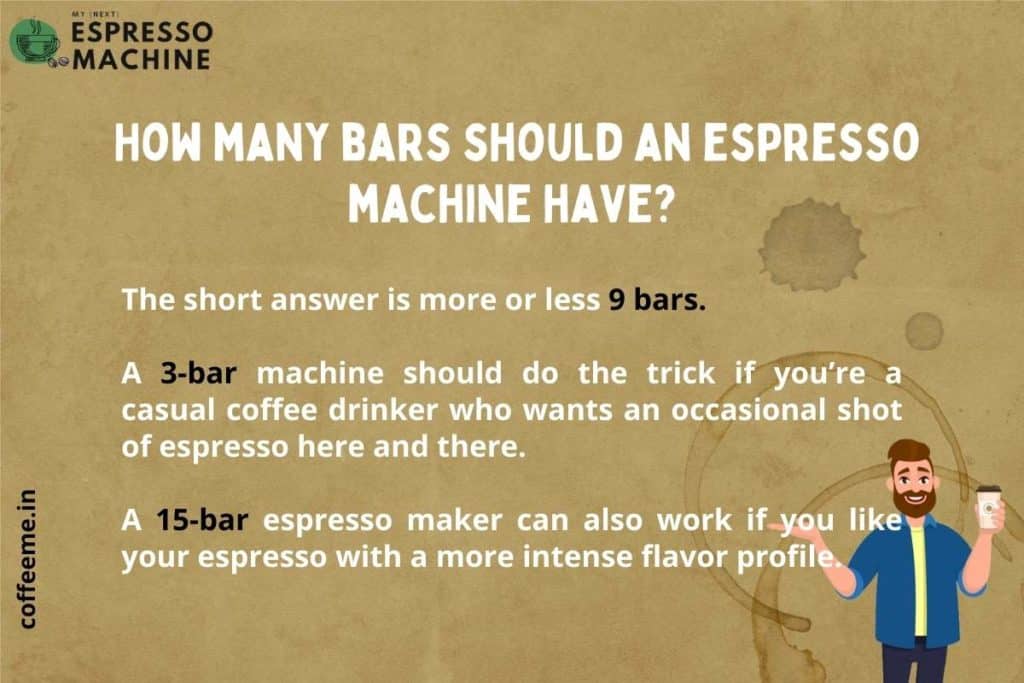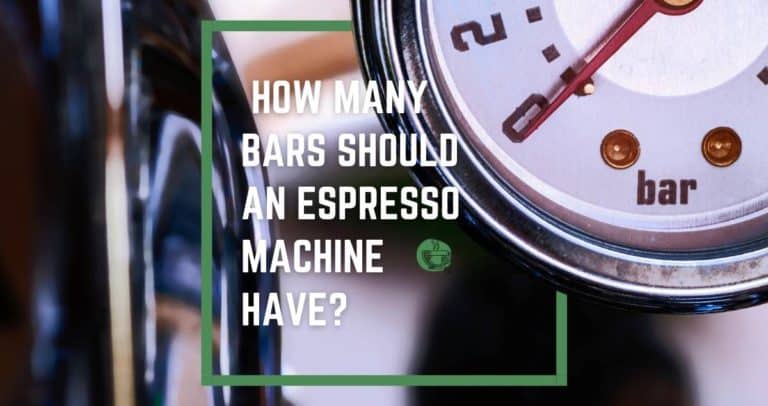When buying an espresso machine, one question often arises: How many bars of pressure should an espresso machine have? The short answer is more or less 9 bars, but here’s a deeper look at what this means and why it matters.
What does bar mean on an espresso machine?
First, let’s start with some basics. Espresso is made by forcing pressurized water through coffee grounds. The pressure is what extracts the unique flavors and aromas from the coffee beans to create that rich, delicious espresso taste.
The higher the pressure, the more flavorful and aromatic the espresso. However, too much pressure can result in a bitter taste. That’s why most espresso machines have a pressure of around 9 bars. It’s the sweet spot for producing rich, flavorful espresso without bitterness.
Why is pressure in bars important for an espresso machine?
The pressure in bars is vital for an espresso machine because it determines the flavor and aroma of the espresso. The higher the pressure, the more flavorful and aromatic the espresso. However, too much pressure can result in a bitter taste. That’s why most espresso machines have a pressure of around 9 bars. It’s the sweet spot for producing rich,
How many bars should my espresso machine have?
As we mentioned, most espresso machines have a pressure of 9 bars. This is the ideal pressure for making rich, flavorful espresso. However, if you’re looking for a slightly different flavor profile, you can experiment with other pressure levels.
For instance, some people prefer a more mellow espresso flavor. In this case, you might want to try an espresso machine with a lower pressure of around 5 or 6 bars. On the other hand, if you’re looking for a more intense espresso flavor, you might want to try a machine with a higher pressure of 10 or 12 bars.
Ultimately, it’s up to you to decide what flavor profile you prefer. Experiment with different pressures and find the perfect espresso machine for you.
Are 3.5 Bar Espresso Machines Good?
A 3.5 bar machine at home may be enough for you if you’re a casual espresso drinker. Pressure-wise, it’s not ideal, but if you use your espresso maker properly with good quality coffee, I believe you’ll enjoy even a machine with low pressure. Remember that the flavor profile will differ from what you get at a good cafe.
Is a 20-bar espresso machine good?
Now that we know how many bars your espresso maker should have, let’s address the 20-bar machines.
Generally speaking, a 20-bar espresso machine is good. It’s powerful enough to produce rich, flavorful espresso and allows you to experiment with different flavor profiles.
If you’re looking for a mellower espresso flavor, you might want to stick with a 9-bar machine. Conversely, if you’re looking for a more intense flavor, a 20-bar machine may be perfect for you. However, remember that a 20-bar espresso machine may be too powerful for some people.
To sum up, a 20-bar espresso machine is good, but it may be too powerful for some people. If you’re unsure what flavor profile you prefer, we recommend starting with a 9-bar machine and experimenting.
What’s the difference between a 9-bar vs. 15-bar espresso machine?
Now let’s compare 9-bar and 15-bar machines. We have already established that a 9-bar espresso maker is suitable for producing rich, flavorful espresso without bitterness. However, a 15-bar espresso maker allows you to experiment with more robust flavor profiles.
If you’re looking for a more intense espresso flavor, a 15-bar machine may be the perfect choice for you. However, remember that a 15-bar espresso machine is more powerful than a 9-bar machine and may be too much for some people.
What’s the difference between a 15-bar vs. 20-bar espresso machine?
Now let’s compare 15-bar and 20-bar machines. We saw that a 15-bar espresso machine would produce more robust coffee than the classic 9-bar machines. A 20-bar espresso maker is even more powerful and allows you to experiment with more robust flavor profiles.
How many bars are Nespresso machines?
Nespresso machines have a pressure of 19 bars. This high pressure allows the Nespresso machine to extract rich, flavorful espresso from the dedicated Nespresso pod without bitterness. If you’re looking for a more intense flavor, a Nespresso machine may be perfect for you. However, remember that a Nespresso machine is more powerful than a 9-bar machine and may be too much for some people.
How many bars of pressure does Starbucks use?
Starbucks espresso machines have a pressure of 15 bars.
Do commercial espresso machines require higher bar pressure?
The answer is yes and no. Many commercial espresso machines have a pressure of 15 bars or more. However, some commercial machines have a lower pressure of 9 bars. It all depends on the model and the desired flavor profile.
Pump driven Vs. Steam-driven espresso machines
Now that we’ve covered the basics of espresso machine pressure let’s compare pump-driven and steam-driven machines.
We recommend a pump-driven machine if you’re looking for the best-quality espresso machine and willing to pay for it. Pump-driven machines are more powerful than steam-driven machines and can produce rich, flavorful espresso. However, they are also more expensive.
Steam-driven machines are less powerful than pump-driven machines and may not be able to produce rich, flavorful espresso just as well as pump-driven machines. However, they are less expensive and may be a good choice for budget-conscious shoppers.
What other criteria are important when buying a new espresso machine?
Remember that pressure is not the only criteria to examine when buying an espresso maker. Let’s discuss other things to consider before purchasing your next machine.
- Size – You’ll want to think about what size machine. A small espresso machine may be all you need if you’re a casual coffee drinker. Conversely, if you’re a heavy coffee drinker or if you entertain often, you’ll want a bigger machine.
- Features – Consider the features you need. For example, some machines come with built-in grinders, while others do not. If you prefer convenience, you’ll want to choose an espresso machine with a built-in grinder. You may not need this feature if you already have a quality grinder.
- Price – Consider your budget. There is a wide range of prices for espresso machines. You can find quality budget espresso machines for under $200 or spend several thousand dollars on a high-end model. It all depends on your budget and your needs.
- Maintenance – Some machines require more maintenance than others. If you’re not comfortable with regular maintenance, you’ll want to choose a model that is easy to maintain— for example, pod-based espresso machines.
- Warranty – Most espresso machines come with a one-year warranty. However, some companies offer more extended warranties for an additional cost. If you’re worried
What else might influence espresso taste besides BARs?
Other factors can influence espresso taste, such as water quality, bean quality, and grind size.
- Water quality – The water you use to make coffee can impact the taste. If you’re using tap water, it might contain impurities that can affect the flavor of your coffee. We recommend using filtered or bottled water for the best results.
- Bean quality – The coffee beans you use will also affect the flavor of your coffee. If you’re using lower-quality beans, your coffee might not taste as good as it could. We recommend using high-quality beans for the best results.
- Grind size – The grind size can also affect espresso flavor. A finer grind will produce a more robust flavor, while a coarser grind will be more mellow. Experiment to see what grind size you prefer.
- Roast level – The roast level of your beans can also affect flavor. A darker roast will produce a bolder flavor, while a lighter roast will be more mellow. Again, experiment to see what you prefer.
These are just a few of the factors that can influence espresso flavor. Attention to them will ensure you make the best of your espresso machine, regardless of the bar pressure.
Does the pressure of my espresso machine affect coffee crema?
The pressure of your espresso machine does affect the coffee crema. A higher pressure machine will produce more crema than a lower pressure machine. However, the coffee you use and the grind size will also affect crema production. If you’re looking for rich, flavorful crema, choose a high-pressure espresso machine and use fresh, finely ground coffee.

How many bars should an espresso machine have – Final Thoughts
So how many bars should your espresso machine have? As with most things in life, it depends.
A three-bar machine should do the trick if you’re a casual coffee drinker who wants an occasional shot of espresso here and there.
If you’re looking for something more advanced or passionate about making great espresso, you’ll need a machine with around 9 bars. A 15-bar espresso maker can also work if you like your espresso with a more intense flavor profile.
Just remember that bar pressure is not the only factor in making a great espresso. You should also consider the quality of coffee and other criteria when buying a new espresso machine, such as size, design, price, and ease of maintenance.
Keep these tips in mind when shopping for your next (or first) espresso machine, and you can be sure to find one that will make perfect shots every time.



